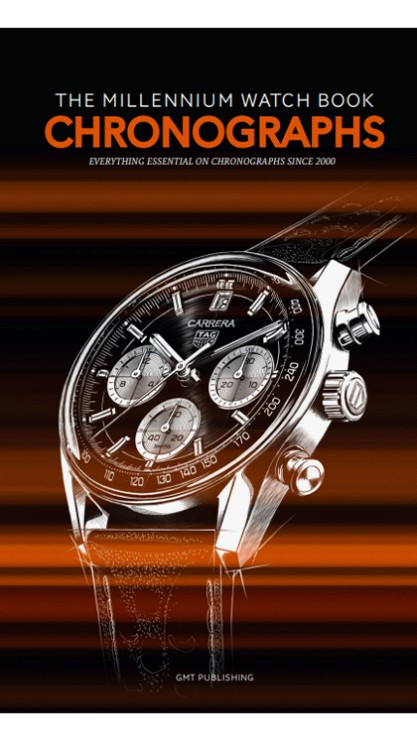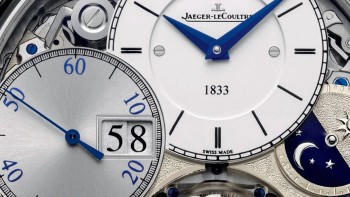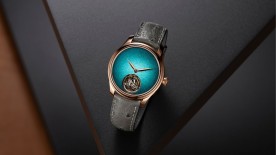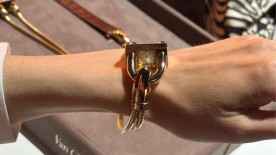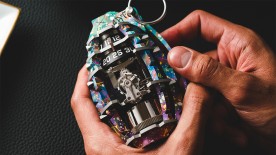The tourbillon is a star. It always hogs the limelight, especially when it’s handled with the levels of sophistication seen in this third work in the Gyrotourbillon series, which helped position the tourbillon as the ultimate complication of the 2000s — always with the same two ingredients. One is a tourbillon with an advanced spatial layout: in this case, it has a spherical cage, rotates around two axes and is of the ‘flying’ variety. More discreetly, the Gyrotourbillons were also accompanied by another refinement or complication. In the case of the Gyro 3 — often so named for simplicity’s sake and/or as a term of endearment — this is a chronograph.
FIRST AND SECOND
Jaeger-LeCoultre’s implementation of this second aspect was always as unusual as what it did for the tourbillon in question. For the first Gyrotourbillon, the calendar was not only perpetual: it was also bi-retrograde. In the second, the hairspring was cylindrical with a double terminal curve and benefited from thermal bluing. The third therefore had to take a similarly off-beat approach to the chronograph, even if the public was likely to be much less interested in this feature than in the spherical cage with its openwork aluminium and flying, bi-axial tourbillon, or the hammered finish nickel silver baseplate. The chronograph ends up being the poor relation in the prestige extravaganza of the piece, despite the fact that the 176 calibre gives it a highly privileged position. It has its own offset dial, distinct from the one displaying hours and minutes. Silvered and with a sunburst finish, it takes up much more room than is normally assigned to a humble counter, and not without reason. It is in fact a complete, autonomous display that brings together a seconds hand and a digital 60-minute counter within a single disc.

ONE, TWO
Mechanical watchmaking rarely uses non-analogue disc-based displays for anything other than dates. Discs are much heavier than hands and the principle of a digital display involves the numbers being perfectly aligned in their window, so they have to be jumping figures. What’s more, heavy, jumping components are extremely power-hungry. Not only that, in addition to jumping, the disc needs to be able to be brought to a sudden halt, so mass becomes a critical issue. In other words, putting a disc in a watch is like having a truck that needs to be able to accelerate from 0-100km/h in under 3 seconds and stop in even less time. And when the disc is for a chronograph, it needs to be able to do so at least once a minute. This is the unsung exploit achieved by the Gyro 3 (although admittedly it was a revamped version of the system inaugurated in 2010 on the Master Compressor Extreme Lab 2). Its display of tens and units for the chronograph minutes is indeed managed entirely by two discs. It’s no exaggeration to say that Jaeger-LeCoultre’s watchmakers tore their hair out in their attempts to get this system working reliably, but the outcome is everything you could expect from a Gyrotourbillon. The grey counter sports two spacious windows in which two very large figures appear, perfectly readable without the aid of a magnifying glass. Nothing like it had ever been seen before.
SIX, NINE
The other challenge in creating this chronograph with its autonomous, offset display featuring a hand and a double jumping disc was that of thickness. Chronographs normally array their indicators in two or three places around the dial. Here, everything’s stacked one on top of the other, apart from the column wheel, slightly to one side and concealed by a screwed-down cover. Fortunately, the spherical tourbillon cage takes up a lot of room itself, inevitably in three dimensions. This means that the platinum case of the Gyro 3 is 15.5 millimetres deep. However, that depth is required for the tourbillon only in a small area at 6 o’clock, leaving plenty of space elsewhere for the movement — enough to house just about anything, provided it’s arranged vertically. The Gyrotourbillon 3 isn’t generally acclaimed for being pragmatic, but that’s precisely what the chronograph at 9 o’clock is.
Jaeger-LeCoultre Gyrotourbillon 3
CASE: steel, sapphire crystal glass and caseback, water resistant to 50m
DIMENSIONS: 43.5mm diameter, 15.5mm thick
MOVEMENT: hand-wound, mechanical; bi-axial flying tourbillon; 176 calibre, 592 components, 3Hz; 48-hour power reserve
FUNCTIONS: hours, minutes, monopusher chronograph, digital minute counter with double-disc instant jumping display, day/night indicator
DIAL: white lacquered hours and minutes dial, sunburst silver-toned chronograph dial
STRAP: black alligator, platinum folding clasp
LAUNCH YEAR: 2013
This year GMT Magazine and WorldTempus have embarked on the ambitious project of summarising the chronograph since the year 2000 in The Millennium Watch Book - Chronographs, a big, beautifully laid out coffee table book. This article is an extract. The Millennium Watch Book - Chronographs is available in both French and English here.
